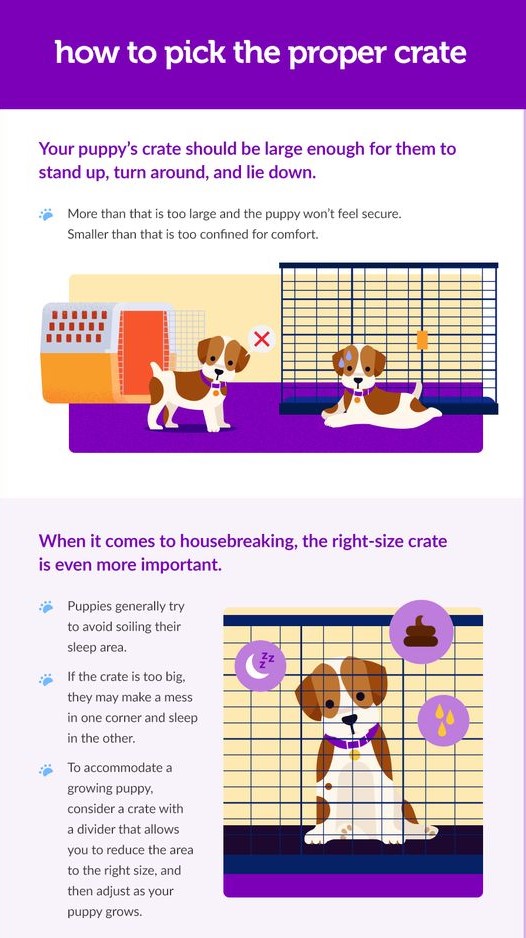To crate train a puppy at night, start by placing the crate in your bedroom near your bed. Then, gradually move the crate to your preferred location.
Furthermore, associate the crate with positive experiences like treats and toys to make it a comfortable space for the puppy. Avoid using the crate as a punishment, and be patient during the training process. Crate training a puppy at night can be a beneficial way to establish good sleeping habits and provide a sense of security for your furry friend.
It helps in preventing accidents and destructive behavior while promoting a routine for your puppy. By following some simple steps and understanding your puppy’s needs, you can effectively crate train your puppy at night for a happy and peaceful sleep for both you and your furry companion.
Preparing For Crate Training
Preparing for Crate Training: Before starting crate training at night, it’s important to set up the crate area and choose the right crate size for your puppy. The crate should be big enough for your puppy to stand up, turn around, and lie down comfortably, but not too large that it allows them to soil one end and sleep in the other. Place the crate in a quiet, draft-free area, away from direct sunlight and any potential hazards. Adding comfortable bedding and a few toys can make the crate a more inviting space for your puppy.
Getting Started With Crate Training
Crate training a puppy at night can be a valuable tool in their overall training and development. The first step is to introduce the puppy to the crate in a positive and calm manner. Start by placing treats or toys inside the crate to encourage them to enter. Gradually increase the time they spend inside the crate, always ensuring that it remains a positive experience. Use a soothing and reassuring tone when placing them in the crate at night.
It’s important to remember that puppies have small bladders, so be prepared for nighttime bathroom breaks. Place the crate in a quiet and secure area of the house, away from any distractions. Consistency is key in crate training, so aim for a regular routine and stick to it. With patience and persistence, your puppy will soon form a positive association with their crate, and sleeping through the night will become a breeze.
Nighttime Routine For Crate Training
Establishing a consistent nighttime routine is crucial when crate training a puppy. By following a structured approach, you can help your furry friend feel secure and comfortable in their crate during the night.
One of the key aspects of crate training is establishing a bedtime routine. Designate a specific time for your puppy to go to bed and be consistent with it. This will help them understand when it’s time to sleep.
When addressing nighttime whining, it’s essential to remain calm and patient. Whining is normal for puppies when they’re getting used to the crate. Don’t give in to the temptation of letting them out or scolding them. This will only reinforce the behavior.
Provide comfort items, such as a soft blanket or a favorite toy, to make the crate a cozy space. However, make sure to avoid using anything that could pose a suffocation or choking hazard.
Incorporating positive reinforcement is key to successful crate training. Praise and reward your puppy when they enter the crate willingly or remain quiet during the night. This will reinforce the idea that the crate is a safe and comfortable place.
Remember, consistency is the key to crate training success. Be patient, and in time, your puppy will learn to love their crate and have peaceful nights of sleep.

Credit: suburban-k9.com
Handling Nighttime Accidents
When crate training a puppy at night, accidents can happen. It’s important to clean the crate properly to prevent any lingering smells that may attract the puppy to soil in the same spot. Strategies for minimizing accidents include:
- Using a crate that is just big enough for the puppy to stand up, turn around, and lie down comfortably
- Taking the puppy outside to eliminate right before bedtime
- Setting an alarm to wake up and take the puppy out during the night
- Not leaving food or water in the crate overnight, but ensuring the puppy has access to them during the day
- Using waterproof bedding or puppy pads to protect the crate
- Praising and rewarding the puppy for eliminating outside and using the crate properly
By following these steps and establishing a consistent routine, you can successfully crate-train your puppy at night and minimize accidents.
Troubleshooting Common Issues
Have trouble with crate training your puppy at night? Learn how to troubleshoot common issues, such as whining or barking, by gradually acclimating your puppy to the crate, using positive reinforcement, and providing comfort items. Consistency and patience are key to successful crate training for a peaceful night’s sleep.
| Separation Anxiety | Address this by gradually increasing time away and providing comfort items. |
| Excessive Barking | Use positive reinforcement training and ensure enough exercise to reduce barking. |
Use a gentle approach to gradually acclimate your puppy to being alone at night. Ensure a comforting environment with a cozy bed and familiar toys. Provide mental stimulation during the day to prevent anxiety. Consistency is key in training your puppy.
Gradual Crate Training Progression
Embark on a gradual crate training progression to help your puppy sleep soundly at night. Start by making the crate comfortable with bedding and toys, then gradually introduce short intervals of crate time. Consistency and positive reinforcement are key to successful crate training.
| To crate train a puppy at night: |
| Start by gradually getting your puppy accustomed to the crate. |
| Increase the duration in the crate slowly to avoid stress. |
| Move the crate to different locations to help the puppy adapt. |
Celebrating Crate Training Success
Crate training a puppy at night can be a successful and rewarding experience for both you and your furry friend. Consistency is key when it comes to reinforcing positive behavior. Reward good behavior with treats and praise to create a positive association with the crate. It’s important to establish a routine and stick to it. Try to maintain a regular schedule for feeding, playtime, and bathroom breaks.
Additionally, make sure the crate is cozy and inviting. Add a comfortable bed and some toys to make it feel like a safe space for your puppy. Remember, patience and perseverance are essential for successful crate training.

Credit: m.youtube.com
Frequently Asked Questions
How Do I Get My Puppy To Stop Crying At Night In His Crate?
To stop your puppy from crying at night in his crate, gradually accustom him to it, offer comfort items, maintain a consistent routine, and refrain from giving in to his cries.
How Long Does It Take To Night Crate Train A Puppy?
Night crate training for a puppy can take 2-4 weeks but can vary depending on the puppy’s age and temperament. Consistency and positive reinforcement are key for successful training. Gradually increase the duration the puppy stays in the crate at night to help them adjust.
Should A Puppy Sleep In A Crate All Night?
Yes, it is beneficial for a puppy to sleep in a crate all night for their safety and security.
Should I Lock My Puppy In His Crate At Night?
Yes, you can lock your puppy in his crate at night. It provides him with a safe and cozy space and helps with potty training and preventing destructive behaviors. However, ensure the crate is comfortable and give him enough exercise and mental stimulation during the day.
Conclusion
Incorporating crate training into your puppy’s bedtime routine can lead to a peaceful night for both you and your furry friend. By patiently introducing the crate, making it comfortable, and using positive reinforcement, you can teach your puppy to enjoy spending time in their crate at night.
With consistency and patience, your puppy will learn to see the crate as a safe and secure haven, allowing for peaceful nights for all.

Hello, I’m Ethan Mitchell. My passion is dog training and behavior enthusiasts. With years of experience working with various breeds, my goal at Dog Advisor Pro is to help dog owners build strong, loving relationships with their furry friends through effective training techniques. Understanding a dog’s behavior is the key to harmonious companionship. I am dedicated to sharing practical training tips that improve the lives of dogs and their owners.


